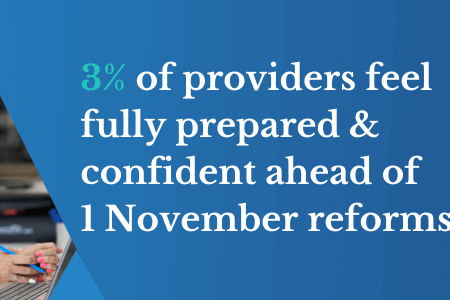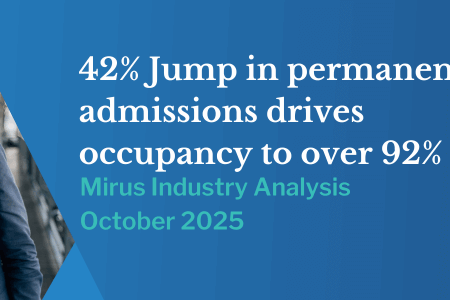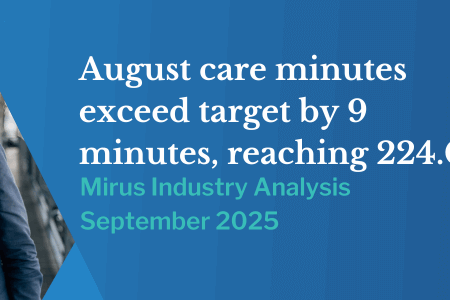How to plan your workforce to meet care minute targets
June 8, 2023 | AN-ACC

By Tom Murphy, General Manager of Product and Operations
As we near the final quarter before compliance with care minutes becomes mandatory, many aged care providers are reliant on manual and retrospective processes to track and report on care minutes. This requires significant investment of time and often results in unexpected star ratings as the Quarterly Financial Report (QFR) is submitted.
In this blog, we explore different strategies aged care organisations could incorporate into their workforce and roster planning to proactively ensure care minute targets are met whilst continuing to deliver high-quality care, optimal resource allocation, and budgetary compliance.
Calculating your cumulative average
Not only is it important to have a well-defined plan to meet care minute targets, but we also need to be able to track compliance to this target as the reporting period unfolds. This involves understanding the cumulative calculation of care minutes which is the total of direct care minutes divided by the total bed days in the given period.
For example, the achieved care minute average for an aged care facility on 31 May 2023 can be calculated with the following assumptions:
(Very important – don’t forget to include agency hours!)
- Quarterly care minute target: 195 minutes
- Total direct care hours worked between 1 April and 31 May (inclusive): 21,452
- Total occupied bed days: 6,649
- Average daily resident count: 109
(21,452 x 60 minutes)/6,649= 193.58 minutes per resident per day
Against a target of 195 care minutes, this aged care facility would be 99% on track and would likely need to roster an additional 7.8 hours per day for the remaining period to meet the quarterly target.
Ideally, this calculation should be run at the end of the day or least after every roster period to understand what changes need to be made to staffing to stay compliant. Effectively running the QFR on demand.
By regularly reviewing progress towards your care minute targets, aged care organisations can ensure they stay on track and adjust where necessary. Integrating a forecast view of the QFR into the planning and review process provides real-time insights and avoids surprises when the report is submitted.
Proactive resource planning
Proactive resource planning plays a vital role in meeting care minute targets. A large part of this comes from understanding the composition of employees whose hours contribute to direct care time. What percentage of your care minutes achieved are worked by permanent, casual and agency? What about other employment types? How should you be viewing hybrid roles?
Over the coming months, here are three key areas to focus on:
- Agency usage
Replacing shifts with agency staff is necessary to address resource challenges, however unplanned agency usage can lead to unexpected costs. By monitoring and forecasting agency usage requirements and optimising permanent and casual staff utilisation, aged care organisations can minimise reliance on agencies and ensure cost-effective care minute contributions. It may even be worth asking your suppliers to consider a reduced rate for planned agency use versus urgent shift fills.
- Employees on Student Visas
During the pandemic, the Department of Immigration temporarily relaxed working restrictions for employees on student visas. This allowed employees to work more than 48 hours per fortnight, however this is set to finish by the end of this year (Work restrictions for student visa holders). This will have a big impact on resource planning to meet care minutes. As Catholic Health Australia pointed out in an article from Sydney Morning Herald, “at least 10 per cent of its workforce are student visa holders, 40 per cent of whom work more than 48 hours a fortnight.” With these changes to working hours, you should assess the percentage of the workforce composed of employees on student visas and the impact of potentially having to reduce their hours. With the reinstatement of maximum working hours, adjustments may be needed to maintain care minute targets.
- Direct Care Roles:
Finally, consider how you are interpreting the care minute guidance into a policy on care minutes. Our workforce analysis engagements are telling us there’s a big percentage of care minutes spread across hybrid roles. For some sites, 25% of a care manager’s time is counting towards direct care, for others this is more like 80%. Striking the right balance between clinical tasks and administrative duties is essential under the AN-ACC funding model. By providing support through task delegation, technology tools, and role restructuring, organisations can empower clinical staff to focus more on direct care, improving overall efficiency. Things to consider as part of this policy review are whether hybrid clinical management roles are focused on the right tasks and whether the organisation could use better tools and processes so they can spend more time in a direct care capacity.
How should technology help?
Technology can significantly enhance how you plan, track and report on care minute targets. Leveraging the right technology solution allows aged care providers to streamline processes, optimise resource allocation, and gain real-time insights. Here are some ways in which your current technology should be able to assist:
- Automated reporting: Automating reporting processes saves time, increases accuracy, and improves efficiency. Real-time costing integrated into the budgeting process enables informed decision-making, allowing organisations to align rostering and cost decisions with care minute goals.
- Data integration: Integrating data on occupancy and acuity provides a comprehensive view of demand and therefore what resources are needed. This data-driven approach empowers organisations to plan and allocate resources more effectively, ensuring adequate staffing levels to meet care minute targets.
- Optimisation of costs: Technology solutions can suggest efficient staffing arrangements, minimising overtime and preventing worker burnout. By optimising costs and ensuring the right staff is assigned to the right tasks, organisations can maximise care minute contributions within budgetary constraints.
- On-Demand reporting: Having the ability to produce the QFR on-demand facilitates continuous monitoring of care minute targets. This feature provides a clear snapshot of the organisation’s progress, enabling timely adjustments and avoiding surprises.
To be in the best possible position to meet care minute targets, it takes a proactive approach towards resource planning, and leveraging technology as much as possible. By carefully planning and regularly reviewing progress, aged care providers can stay on track – at least have an early warning when things start to change.
If you’re ready to save time and eliminate manual processes, click below to learn more about Care Minute Manager.


